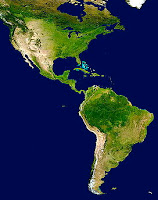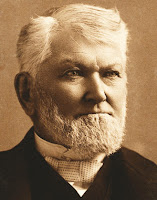This area was just outside the city, perhaps a half a day journey or a little further. And as many as believed in him followed him out to this area. Here Alma stayed, while many of his converts traveled back and forth to the city where they also spread the word and the small group grew from 205 baptized members to 450 (Mosiah 28:35). However, though this was done in the borders of the land and those who returned from time to time back to the city were careful, the king discovered the movement among the people and sent his servants to watch them, and on that day when they assembled themselves at the Waters of Mormon, the king’s guards discovered there whereabouts (Mosiah 18:32)
Lake
Huaypo, about 12 to 13 miles north of Cuzco as the crow flies and about 18-20
miles on foot, this small lake is nestled behind the large hill that screens
the lake from the south where Cuzco is located. Before man settled here, this
entire area was covered with trees, including the hill
Now, this area of
Mormon was infested at times or at seasons, by wild beasts (Mosiah 18:4), and
must have been some distance from the City of Nephi—but likely no more than a
day at most. We have already given our reasoning for believing it to be to the
northwest, since that would make it closer to Zarahemla and fit the distance
factor of the 21 day’s overall journey. Thus, northwest of the City of Nephi
(Cuzco) lies the setting of a small lake called Huaypo, and its adjoining
forest, about thirteen miles away as the crow flies across a wilderness that
can be reached via two routes, the first about 17 miles along what is today
highway 3S to Izcuchaca, and then north and around to the backside or northwest
side of the lake (an area that cannot be seen from the south because of the
hill on the south side of the lake); the other starts out the same along
today’s 3S for about 5 miles, then branches north just past Poroy on the
present road toward Chinchero, winding through the mountains and then branches
off to the northwest and around to the backside of the lake.This second way would be perhaps two to three miles further, and more difficult because of the mountains in between, but more secure from being seen and providing much more protection from wandering guards who might be out looking for them.
Huaypo Lake has a large reed area at one end
filled with Tortora Reeds, similar to the ones found in Lake Titicaca around
Puno
In addition, the lake
is a favorite fishing area, with trout and a perch-like fish at an altitude of
11,000 feet, and both birds and ducks frequent the totoras areas (a local prolific
and dense-growing reed plant found in the lake shallows and provides numerous rushes
and grasses, the favorite habitat for fish and ducks, whose roots are very
edible, and whose flowers can be brewed into a hot drink, likely providing Alma
and his people with both food and drink while in the area.
The backside or north side of Lake Huaypo.
The trees on both bills and in the foreground were ancient a large forest, and
the hill to the left (south) blocked view of the lack and forest from then
south or from the approach from Cuzco (City of Nephi)
If this is correct,
which seems to fit quite well, then Alma would have been in the forest area of
Lake Huaypo, which puts him about 100 miles to the southeast of Machu Picchu,
which we have suggested before would be Amulon, or the location of the evil
priests of king Noah at this time. Along with Alma were 450 baptized converts
(Mosiah 18:35), and they traveled for eight days (Mosiah 23:3), where they came
to a very beautiful and pleasant land, a
land of pure water, where they pitched their tents (Mosiah 23:4-5). This was probably in the area of Vilcabamba, west and a little south of Machu Picchu, where many tropical plants grow in profusion, including ground orchids, wild strawberries, bamboo plants, sugar cane, begonias, and other flowing trees and plants. Many endemic flora and fauna grow here that you can see only in this part of the world. Numerous rivers of pure water from snow melt flow through the wild Vilcabamba Cordilleras.
Alma evidently traveled up the gorge to the west of Machu Picchu intoVilcabamba, covering 20 miles per day, or 160 miles in their eight-day journey, where they settled in an area he called Helam (Mosiah 23:19). This city might have been the area later further founded by the Inca, called Vilcabamba (see below). In any event, a more apt description could not have been given it than Momron’s “even a very beautiful and pleasant land, a land of pure water” (Mosiahg 23:4).
Vilcabamba
Region. The change from the harsher mountains to the east, when entering
Vilcabamba area make it seem like a very beautiful and pleasant place
Indeed a “very
beautiful and pleasant place” (Mosiah 23:4-5) among ferns and lichen in the montane
rainforest (today called the “global epicenter of biodiversity”) and is the
richest and most diverse of Earth’s biodiversity areas covering some 781 square
miles where some 20,000 plants found nowhere else and at least 1500 animals,
including vertebrates, a spectacular array of birds and amphibians.There is an interesting later history of this area involving the Inca after their so-called defeat at the hands of the Spanish. At this time, the last Inca rulers left for some city in the jungles where they lived from 1536 to 1573. The name of the city was Vilcabamba. Spanish friar and chronicler Fray Martin de Murúa describes this place in his Historia General del Pirú (General History of Peru) as follows: “...the Incas enjoyed almost the same luxuries, greatness and splendour of Cuzco in this distant, or, rather exile land. For the Indians brought whatever they could get from outside for their contentment and pleasure. And they enjoyed life there.”
The Spanish could visit these places and describe them in chronicles, but then the location of Vilcabamba was forgotten after the final defeat of the Inca at Sacsahuaman in 1573. Researchers and travelers have been trying to find this place for many years. In 1911 the scientist from Harvard Hiram Bingham visited Peru with the same intention. He found Machu Picchu and believed that it was the fabled Vilcabamba. But further research and comparisons of Vilcabamba with Machu Picchu proved Hiram Bingham wrong.
Espíritu Pampa, believed to be the fabled city of
Vilcabamba, which might also be the original site of Alma’s city of Helam
Most probably, the legendary Vilcabamba is
associated with the Espíritu Pampa, which is located in the jungles about 300
miles north from Cuzco, well beyond Machu Picchu. Hiram Bingham also discovered this
place in 1911 but evidently did not realize its significance and size.
During the centuries after disappearance of the Incas, the tropical forest
almost completely covered the city. Hiram Bingham only discovered several small
buildings and did not pay too much attention to them. This discovery belongs to
American explorer Gene Savoy. He and his Andean Explorers Club expedition
discovered the real size and evidently solved the mystery of Espíritu Pampa –
ancient Vilcabamba in 1964. In this fertile land, they prospered exceedingly, planted and harvested, and because of their industry, they built a city and named it Helam and evidently spent much time there. However, a Lamanite army appeared that had earlier stumbled on Amulon (Machu Picchu, not very far to the east of where Helam was settled), and among them were the evil priests of Noah and their Nephite leader, Amulon. We are not told how long the Lamanites and Amulon controlled Alma and his converts, but long enough to show the Lord their patience in living under the heavy hand of Amulon and the Lamanites.
Eventually, though the Lord provided a means for their escape, and Alma and his people traveled a day into the wilderness and pitched their tents in a valley they called Alma (Mosiah 24:20, but that stay was cut short when the Lord told them to leave again and they took their journey into the wilderness (Mosiah 24:24), this time traveling 12 more days before they reached the Land of Zarahemla (Mosiah 24:25).





































